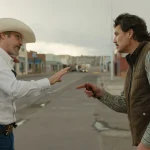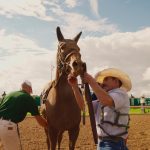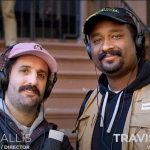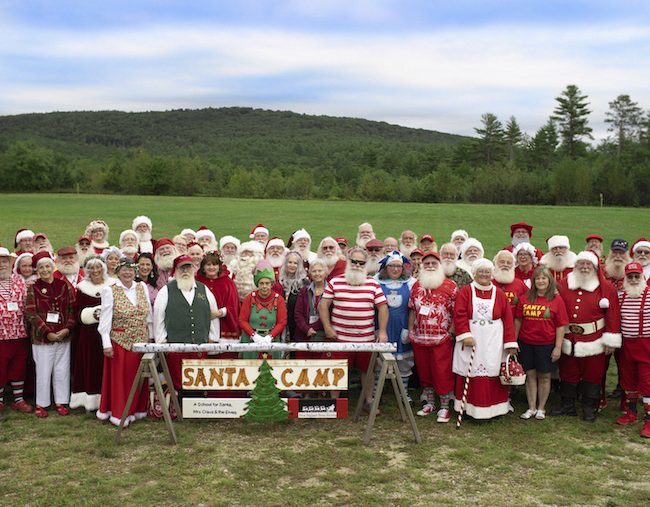A Conversation with Nick Sweeney & Stacey Reiss (SANTA CAMP)
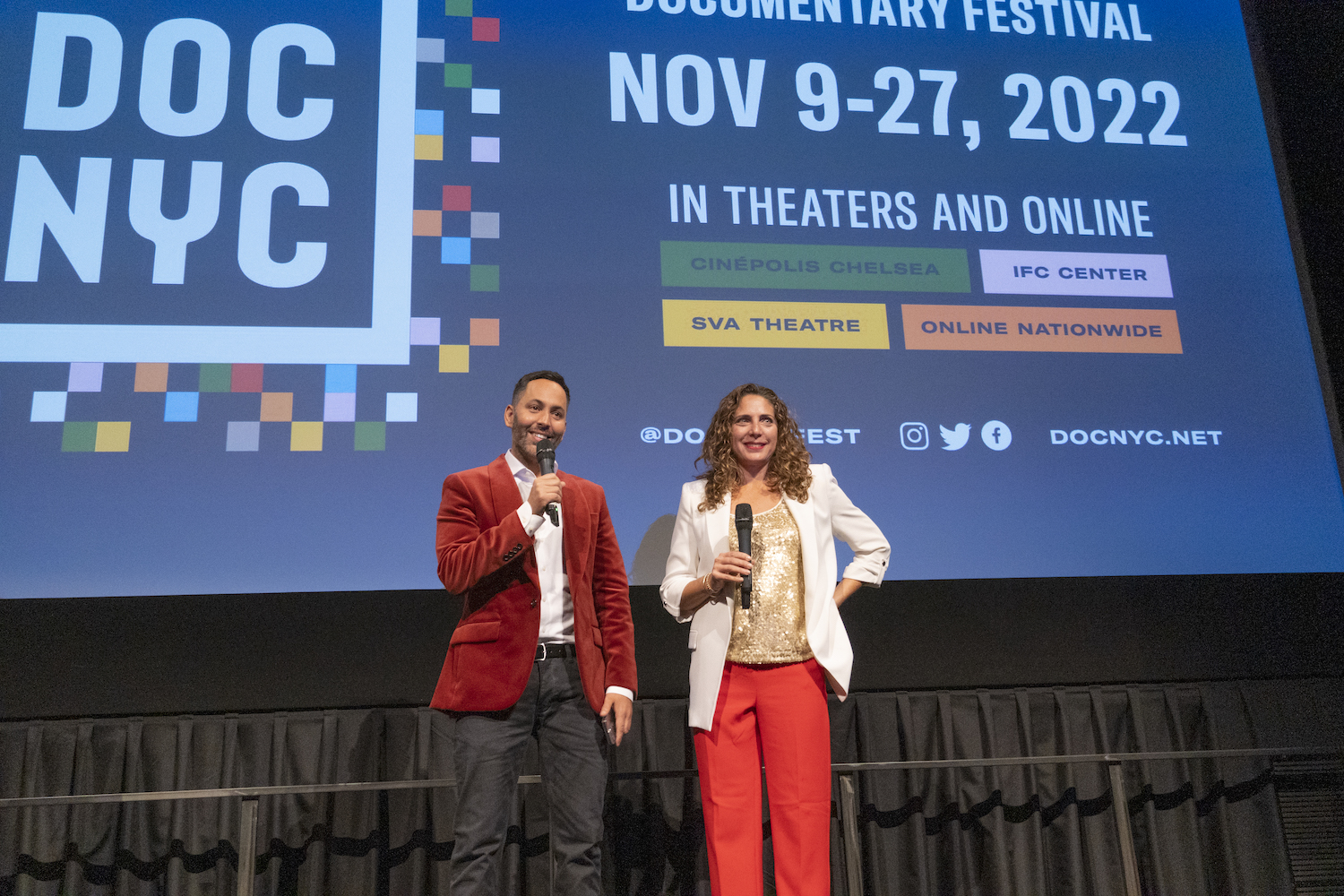
In his new documentary, Santa Camp (which I reviewed out of DOC NYC 2022), director Nick Sweeney (AKA Jane Roe) follows the New England Santa Society as they attempt to diversify their membership and plan for the upcoming Christmas season. Traditionally made up of older, white, bearded men of a certain size, the group decides that it is time to question that identity, even if not all who belong feel open to the idea. And so we meet a fascinating cast of characters in a movie that is funny, sweet, sad, maddening, and always engaging. Just after I left DOC NYC, I spoke by Zoom with Sweeney and his producer, Stacey Reiss. What follows is a transcription of that conversation, edited for length and clarity.
Hammer to Nail: How did you decide to make a film about the New England Santa Society and their attempts to diversify their membership?
Nick Sweeney: I had actually made quite a controversial, and a little bit bleak, film previously about reproductive rights called AKA Jane Roe. And I was determined to make something that was fun and accessible for the whole family. And I thought, what could be more fun than Christmas and how Santas learn to become Santa? And I did some research and found out that there were a couple of different schools that stuck to a pretty rigid curriculum.
And then I found out about an actual summer camp for Santa Clauses, and as a documentary filmmaker, my head started spinning because I was like, how could this be real? How has nobody done something on this? Could there really be a summer camp? My head started spinning and then when I saw photos of them sleeping in bunk beds and sitting around a campfire, I was like, this is so bonkers.
And then when we reached out and asked them, “How are things changing for you guys?” they said that they’d been getting more and more requests for more diverse Santa Clauses, which indicated that they were asking themselves these same questions that all of America was asking itself. So it felt like much more than just a thing about beards and red capes.
HtN: I should say that all of America was asking itself these questions at the time you made the film. Unfortunately, since that brief period of national solidarity in the wake of the George Floyd murder, there has been a lot of pushback in certain quarters to that conversation about racism and anti-racism. When, in fact, was your shoot?
NS: May 2021 was when we started filming with the Society and with the Clauses right up until the very beginning of 2022. So as we were coming out of that first completely disorienting wave of COVID.
HtN: And how did you and Stacey start working together?
Stacey Reiss: We met through a film contact that we have in common and we first met early in 2021. It was the height of COVID. I remember we sat outside in Williamsburg in a coffee place, six feet apart from each other. And Nick told me about the idea he had and asked me if I wanted to go to camp with him. And as you can imagine, coming out of that year of intense seclusion and hibernation, the idea of going to camp with a bunch of filmmakers and Santas made me jump at the opportunity. I loved the idea. I thought it was such a great way to look at the most recognizable icon in the world, with a modern take on it, that no one had done before. It’s been a true joy to make this film.
HtN: And it seems that coming out of AKA Jane Roe, this was a nice change. Although it still tackles some very, very important issues. You didn’t just make a comedy.
NS: It ended up being more controversial than we expected. I certainly never thought for one second that when we began making a movie about Christmas and Santa Clauses that we would be standing face to face with the Proud Boys.
HtN: And I’ll get to that moment in a little bit. So, casting your film—because you often cast a documentary just the same way that you cast a fiction feature—were there other people that you followed that didn’t end up in the finished film? How did that process work of choosing who would be your central characters?
NS: There was nobody that we filmed with that didn’t end up being in the film. Dan, when he first told us that he was interested in reaching out to Santas from different backgrounds, was already in touch with Fin and Suki, and Dianne was a veteran of the camp. And then Chris’ story had gone viral the previous year when Chris received a racist letter in the post. And so Dan was aware of him in that way. And then Levi and Heidi had a much smaller social-media presence. They had done a couple of gigs in Chicago for their LGBTQ+ community. Beyond that, no, there was nobody that we filmed with that didn’t end up being in the film. I think we were really truly shocked at how many twists and turns and huge things happened to each of these people.

A still from SANTA CAMP
As an example, I think when we started filming with Fin and Suki, we said, “What do you want to do this year?” And he said, “I want to be in a parade. I want to be Santa in a parade”. And I think Stacey and I were just like, if this doesn’t happen, how disappointing will it be if this ambitious young Santa Fin, who has this huge dream … it’s not going to be a great thing if he doesn’t get the one thing that he really wants, which was to be in a parade. So yeah, we got incredibly lucky. I think Stacey and I often joke that there’s some Santa stardust that was being sprinkled in front of us as we made this. Because I don’t think we expected that the stories would be so high-stakes and that they would be so satisfying.
HtN: Well, since Stacey’s the producer and it’s the producer’s job to make things happen, I wouldn’t be surprised if it turns out she was sprinkling the stardust and you were just unaware, Nick. (laughs)
SR: (laughs) I was! I like to say that we had fairy dust. I think there are certain projects that magically come together and there are some that you feel like you’re pushing a large boulder up a hill. This was definitely the one where we felt like we had the wind in our sails, for sure. Maybe it was some reindeer carrying us along as we were making the film.
But I think one of the other things to point out is we went to a camp with 100 performers. These are people that are used to being out in the public eye. And I think the people who decide to become Santas and Mrs. Clauses and elves, they’re naturally charismatic. And for us it was more like, “Oh God, how can we get all of these people in the film?” We did those chorus interviews that you see of the Santas and the Mrs. Clauses. That was our way of hitting home some really key points. But also, we wanted to make sure we featured all these incredible people and wanted to hone in on the unique story that Levi and Heidi and Fin had. But they all have great stories of kids they’ve met and families along the way. So it was like a dream for a documentary filmmaker because there were so many people to choose from.
NS: And a nightmare for an editor, because Stacey and I were very insistent that each of the characters be included equally, almost down to the minute. We didn’t want this to shine more light on one of their stories than the other.
HtN: Well, since Stacey mentioned reindeer, if I have one complaint about your movie, it’s that there isn’t more of the reindeer. So somebody was not advocating for those reindeer because they’re so cute and I wanted more of them. So go put more reindeer in.
NS: (laughs) It’ll be in the sequel.
HtN: (laughs) Yes, please. Speaking of featuring all these people, I’ve made documentaries before and there can be a challenge of negotiating access to your characters. Maybe people start to rethink their willingness to participate. I’m thinking about the Zamboni moment with Dianne and her—let’s just call him “difficult”—partner in that scene. Did you ever have times where people who were participating maybe didn’t want to continue or found the content too contentious?
NS: It’s such an interesting question, particularly in the context of people from marginalized groups. They have a healthy and very well-justified suspicion and skepticism about when people from the media contact them and say, “We’re going to make a documentary, would you like to be in it?” I think transgender people, in particular, are so used to reductive one-dimensional portrayals of them in film and TV. And I think that the way that we negotiated that and got around that with Santa Levi, who’s transgender, and also Santa Fin, who is disabled, was just by being extremely upfront with them: “We want to film this and we want to include it in this way and it would be in order to show the way that your story progresses from here to here and this is why it’s important. And I know it’s annoying sometimes to have five random people in your house trudging around,” and so on. But I think just by being extremely upfront with them, it was the only way.
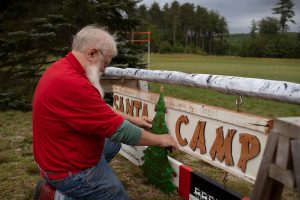
A still from SANTA CAMP
And I don’t believe there were moments where once they were committed they had doubts about participating. But I think Stacey and I were probably hyper-aware of the types of concerns that they might have, just because we’ve worked with stories that deal with that. And I’m gay and Pakistani-Australian, myself, and so I think there’s something of a natural empathy with people from marginalized groups and the suspicions that they have about their depictions. And we played it for them, as well, and they were very happy with the film.
HtN: Thank you for bringing the question back to them, since I was asking more about the curmudgeonly white guy who might not want to be in the film after seeing what he looks like. But what you brought up is much more important. But what about the people who maybe saw how they were being covered in the film and then didn’t want to be in the film? I’m thinking also about that scene where you confront—and it must have been really tense—people like the Proud Boys or people like that Christian woman in the car who’s live-streaming her protest. How did you negotiate? How did that work? This is hardly a film that showcases them in their best light.
NS: I think that those people would feel like they’re showcased in a completely accurate and honest way. They were there publicly protesting something that they objected very strongly to. The Proud Boys felt very strongly that Santa should not be depicted by a person who’s transgender. So the idea that they are not portrayed in a flattering light is obviously a subjective one. And I think they would feel like they said their peace.
And what’s really interesting about that scene is that when the Proud Boys showed up, the first thing that I heard was them yelling “Keep Christ in Christmas.” I wasn’t sure what was happening and went over and asked them why they were there. And strangely, by the end they talked themselves out and left. And it’s not actually included in the film, but they started caroling, they started singing “Jingle Bells” and walked away down the street because they’d kind of talked themselves out.
They’d said the stuff that they wanted to say and those are the things that are included in the documentary and it’s very accurate to what they were saying. And they were certainly aware and they all gave permission to be included. And I can understand how you’d be curious about that, because some of the things that they say are quite shocking and bizarre and surreal to listen to, especially that part about how they’re “Proud Boy elves,” for example, which is just such an odd thing to hear. But these are the things that they said and that they feel passionately about.
HtN: From a filmmaking point of view, I really like how you seamlessly cut from the live-stream in the car to just outside the car. That was really cool.
SR: Just to echo what Nick said, I find that what they’re saying may not be my point of view and I find them to be people I would not want to have dinner with, frankly, but I think if you follow this story—even back from when Megyn Kelly first made those comments on Fox News all those years ago—if you look on social media and you read the comments, they’re horrifying to this day. So the Proud Boys are not even as extreme as some of the stuff that we’re reading in the posts. Clearly, it’s a very divisive issue, like many things in this country right now.
HtN: Absolutely. To talk about something less controversial, you have that montage of the Santas in kayaks where you use Enya’s “Only Time,” which of course is a song that I’m sure you had to negotiate the rights to. So what was that like?
NS: We used three very well-known tracks in the film. One is Donna Summers’ “I Feel Love,” another is The Notorious B.I.G.’s “Juicy,” and the other is Enya’s “Only Time.” And funnily enough, Enya’s “Only Time” and Donna Summers “I Feel Love” were initially in the edit as temp tracks. We didn’t initially think that we would be able to get them, and I’ll let Stacey take the story from there.
SR: The incredible part is that we would tell people what the film was about, and for the “Juicy” track shared a clip of Chris and it was like that magic fairy dust again. Everyone wanted to be part of this. And in fact, I’ve cleared lots of music for film and TV over the years for my projects and I’ve never had one of the license holders want to then talk to me because they were so excited to hear more about the film. But one of the people on the publishing side of the “Juicy” track wanted to hear more about it. So I think sometimes you have projects that get lucky and get these really iconic tracks. And we feel like people have really commented on the music and the original score. I think the composer did a beautiful job. It really elevates the project.
HtN: Well, let’s give a shout-out to your composer, then. What’s the name?
NS: The composer is Oliver Chang and he did an absolutely extraordinary job with the score. And those particular tracks, there was no way to score anything that landed in the same way as Enya or Donna Summer just because of the familiarity of those particular tracks. And we use them at the very beginning, the very middle and the very end of the film. But beyond that, the score is also a really remarkable one that we’re incredibly proud of Oliver for creating.
HtN: Thank you for that explanation and thank you for making the film.
NS/SR: Thank you so much.

